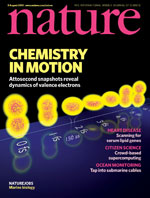If you look at the image of an atom in a text book, it looks rather quiet and peaceful. There is a nucleus in the center made from a number of protons and neutrons. Around the nucleus the electrons typically are shown to orbit the core like planets around the sun.
The reality, however, is far more complicated. First of all, the electrons don’t look like small planets, but are smeared out in complex shapes known as orbitals. The energy states of the different orbitals correspond to the electron shells in atomic physics. And secondly the electron motion is extremely fast, on the timescale of a femtosecond (fs), which is 10-15 seconds. This is so short that even light can’t move very far in such a short time. Within a femtosecond it travels only about a third of a micrometer. So the question is, how is it possible to take a snapshot of such a fast motion? Well, one needs to use a camera that is even faster.
This ‘camera’ is a laser with attosecond resolution. An attosecond (as) is a thousand times faster than a femtosecond. In the present case, pulses of 150 as were used. These lasers are seriously fast. So fast that the light wave in the laser pulse completes only about one cycle. A bit like a tsunami wave that consists of only one big up and downwards motion of the water. Attosecond lasers were pioneered among others by Ferenc Krausz, with the clear aim of using them to venture into the intriguing realm of attosecond science. And it is his group that has now accomplished another major feat: the imaging of electron motions in the outer orbitals of krypton atoms. Their study appears in this week’s Nature, where it was also chosen for the cover.
The knowledge of such electron motions helps to understand the processes that occur during chemical reactions. If we could take a direct look at such processes, pathways in chemical reactions might be better understood.
Yet even with an attosecond laser the imaging of electron motions in the outer shells is not an easy task and requires a couple of tricks. Indeed, what the authors measure is an interference effect between two electronic states: an electron from the outermost occupied shell of krypton is removed by one of these laser pulses. This creates a positively charged krypton ion, with an empty ‘space’, a hole, in its outer shell. The hole in that outer shell has two energy levels to choose from. The energies of these states are close together, so the hole ends up oscillating back and forth between the two states. This oscillation is extremely fast, only a few femtoseconds long.
To image that oscillation, Krausz and colleagues use a second laser pulse to excite this krypton ion into yet another excited state. Simultaneously, they measure the amount of light from that second laser pulse that is absorbed by the atom. The energy where the light absorption occurs depends on which of the two original states the hole was situated during its oscillation process. Indeed, a clear oscillation pattern in the absorption spectra from one energy state to another is direct evidence of the original hole oscillation. The period of that oscillation is only 6.3 fs long.
A picture now emerges of the krypton ion’s dynamics of the outer shell. The yellow shapes on the Nature cover depicts schematically the change to the orbitals of these outer states during the oscillation process.
These experiments on krypton gas without doubt are extremely challenging. However, the next key step will be to use a similar approach on more complex systems. Krypton is a noble gas and doesn’t react with other elements. Therefore, the knowledge gained on the electron dynamics during actual chemical processes remains limited. It will be thrilling to see similar studies done on molecules or solid crystals.
Reference:
Goulielmakis, E., Loh, Z., Wirth, A., Santra, R., Rohringer, N., Yakovlev, V., Zherebtsov, S., Pfeifer, T., Azzeer, A., Kling, M., Leone, S., & Krausz, F. (2010). Real-time observation of valence electron motion Nature, 466 (7307), 739-743 DOI: 10.1038/nature09212



August 5, 2010
Atomic Physics, Chemistry, Condensed Matter Physics, Photonics